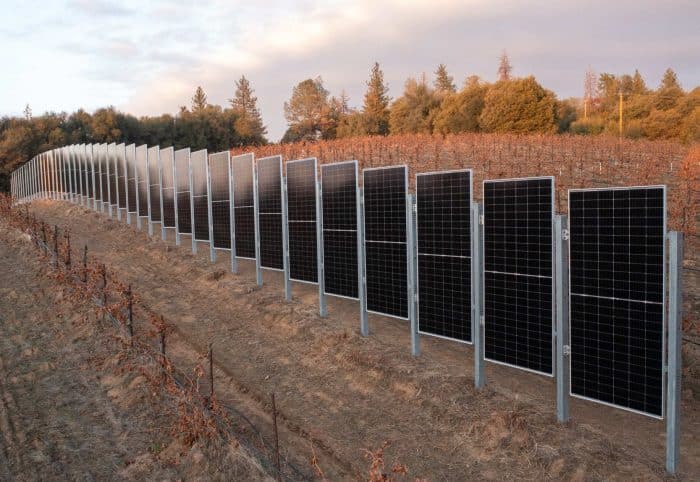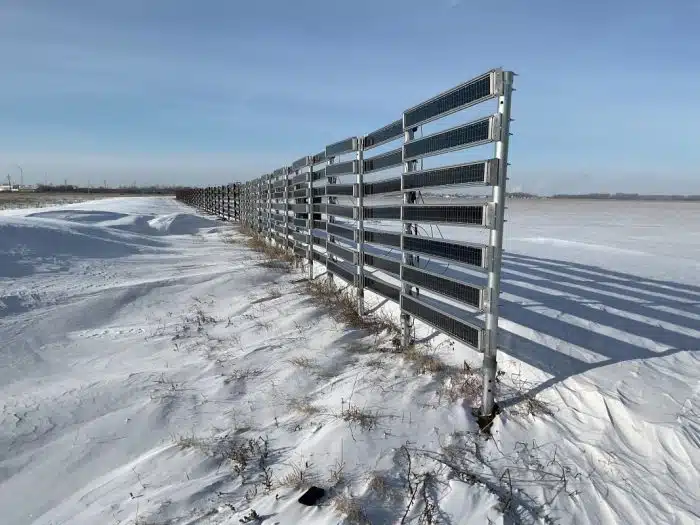
When solar freakin’ roadways hit social media in 2014, most of us in the industry rolled our eyes so hard we pulled our extraocular muscles: Putting cells under glass crazy-thick enough to carry traffic, catching intermittent light between the cars using the road as a road, and filtering those flashes of light through road-based dirt … it was just silly.
Are solar fences just another application that is more fun to think about than functional? Some, like BloombergNEF’s Jenny Chase, argue solar fences, like residential and small commercial solar, are not the highest and best use of the limited supply of solar panels and may cannibalize demand for existing “standard” solar.
But niche markets exist for niche reasons that are far from spurious, and there is a strong case for solar fences. Interest in solar fences is coming from sectors as varied as agriculture, transportation, commercial real estate, and water infrastructure, said Helge Biernath, president, CEO, and founder of Sunstall, a California-based solar company that has worked in 38 states, focuses on 1 to 50 MW projects, and offers Sunzaun solar fence racking.
Why solar fences, why now?
A few tipping points have made solar fences more feasible. First, modules have become cheap enough that they are competitive with some types of fencing once the value of energy production is figured in.
Second, the prevalence of bifacial modules and the rise in module efficiency have increased yield enough that the losses from vertical installation are not necessarily a deal-killer, especially when run in a north-south orientation to get morning and afternoon production or where there is no option for a rooftop or ground mount system.
Third, the increasing electrification of everything from homes to farm equipment combined with rising utility rates has increased the need for distributed generation. Finally, for architectural installations, black-frame, black- or no-backsheet modules can create a modern aesthetic that old poly-silver-frame-white-backsheet modules couldn’t.
Multipurpose solar fences
The variety of ways that solar fences are being used keeps expanding, and while some applications are replacing vertical structures that need to be built anyway, such as residential or agricultural fencing or highway sound barriers, others are installed where no fences exist today, such as within large crop fields. These include places that are otherwise unproductive, Beirnath said, such as freeway shoulders and at the edges of commercial parking lots, especially those with EV chargers. Add a printed wrap, and they can support branding or advertising that reduces the yield a little but gives them an additional purpose.
Beirnath is seeing interest from more northern climes, such as Alberta, which is so far north that the losses from the vertical installation aren’t as significant, and the chance of snow boosting the winter-time production from bifacial modules is greater. Solar fences are also being tested for California’s irrigation canals: Covering the canals with solar may decrease evaporation more than solar fences, but fences are significantly less expensive to engineer and construct and still reduce evaporation, he said.
Solar fences 101
Solar fences are essentially a racking system where the modules are installed vertically. Various solar fence racking systems are available — including portrait or landscape and one, two, or three modules tall — and can be matched with the need.
Beirnath’s Sunzaun is a one-portrait system with multiple slots on each post for the racking attachment. The one-portrait system means “we have more posts, but we’re very flexible when it comes to the module sizes,” he said. This flexibility has been key for some EPCs because it solves “a huge problem: the EPC can see changes to the modules two weeks prior to installation.”
The multiple slots enable the solar module to be mounted at different heights on the same post, so a module can be attached at one height on the left side of the post and a different height on the right to follow the terrain. Horizontal installation would require railing between the posts, decreasing flexibility and lowering the ability to follow a site’s slope, he said. The ability to follow rolling terrain has been an advantage in Sunzaun installations in vineyards in California.
Solar fences are usually mounted with a gap between the bottom edge of the module and the ground, not only for electrical code reasons, Beirnath said, but also to lessen shading from low-growing plants in vineyards or cars parked in lots. Images of residential solar fences in Europe show configurations run to ground level, with landscape orientation for low fences and portrait for full-height privacy fences.
Oh, give me land, lots of land, but don’t fence me in
The classic cowboy song hearkens back to an era when fences weren’t as common, but today rural America depends on fences. There are millions of miles of farmland fences throughout the U.S., defining fields, keeping stock in place, or even protecting solar arrays. According to a Grand View Research analyst report, the agricultural fencing market was estimated to be $2.4 billion in 2022 and will rise another $1 billion by 2030. “The increasing consumer preference for farmland safety and security is expected to contribute to market growth.”
Of course, traditional farming fences — whether wood, barbed wire, or stable mesh — are lower cost than solar fences. But some are betting farmers will consider opting for a fence that does double duty: protects their land and powers their farm (or sells back into the grid, if allowed).
Impact on crops?
Beirnath has put together conferences with academics from agriculture programs and large producers of crops such as berries, all of whom are looking for data on the impact of solar fences on crops. Solar integrated with crops, even when installed vertically, can impact the microclimate, reducing evaporation, and keeping temperatures steadier, resulting in higher yields.
There is a wide range of solar fence solutions for farms, said William Kanitz, owner of et-sun, a Florida-based solar fence specialist installing and consulting through North America. For example, in hay fields, they can be installed based on the width of the combiner that the farm uses. He recommends using bifacial modules for increased yield and said that the vertical configuration means less cleaning is required.
Electric equipment boost
In the agricultural sector, farmers are increasingly looking to electric tractors or have electric pumps and irrigation systems and don’t want to sacrifice productive land to ground-mounted solar, so a fence that is spaced just so (say, a combiner’s-width apart), may provide affordable “fuel” for an increasingly electrified farm. And those big tractor batteries can help smooth load throughout the day, a service that Grid Tractor offers (without using solar fences at this stage).
Kanitz said that farmers considering solar fences may be able to get government-guaranteed loans and grants through the Rural Energy for America Program (REAP).

Harnessing energy from solar snow fences
In the heart of the Northern United States, an innovative trial is underway that combines traditional snow fencing — permanent or seasonal fencing that stops snow drifts from blocking roadways — with renewable energy technology.
“The idea stemmed from a curiosity about whether snow fencing could serve a dual purpose of controlling blowing snow and producing energy,” said Dan Gullickson, Blowing Snow Control Supervisor at MnDOT. This project, a collaboration with North Dakota State University (NDSU), involved a 100-foot section of fence with six-inch wide horizontal solar panels. The test fence could power a typical home, though the output was used to power melting pads next to the fence.
The solar components on the test fence were custom-built. NDSU purchased and fabricated long, thin solar panels on aluminum rails specifically designed to withstand the harsh winds typical of the area, which can have up to 500 hours of windblown snow each winter. The team is evaluating potential partnerships with solar energy companies to explore commercializing technology for this niche application.
“Snow fences need to be somewhat porous to capture the blowing snow. We’ve found that 50% porosity snow fences are the most efficient at capturing blowing snow, so we wanted to be close to that 50% porosity in this project,” he said.
The snow fence does not use bifacial modules, so the fence is oriented east to west with the solar panels facing the south to optimize solar energy capture. There is no wire management system being tested at this stage.
As for the future of this innovative approach, Gullickson remains cautiously optimistic. “We’re still collecting data and information,” he said. “We would also need to partner with adjacent private landowners, so still a lot to consider.”
Dej Knuckey is a contributor to Solar Builder. She is a journalist, author and freelance writer who has covered energy for publications in Australia and the U.S.
— Solar Builder magazine

Leave a Reply
You must be logged in to post a comment.